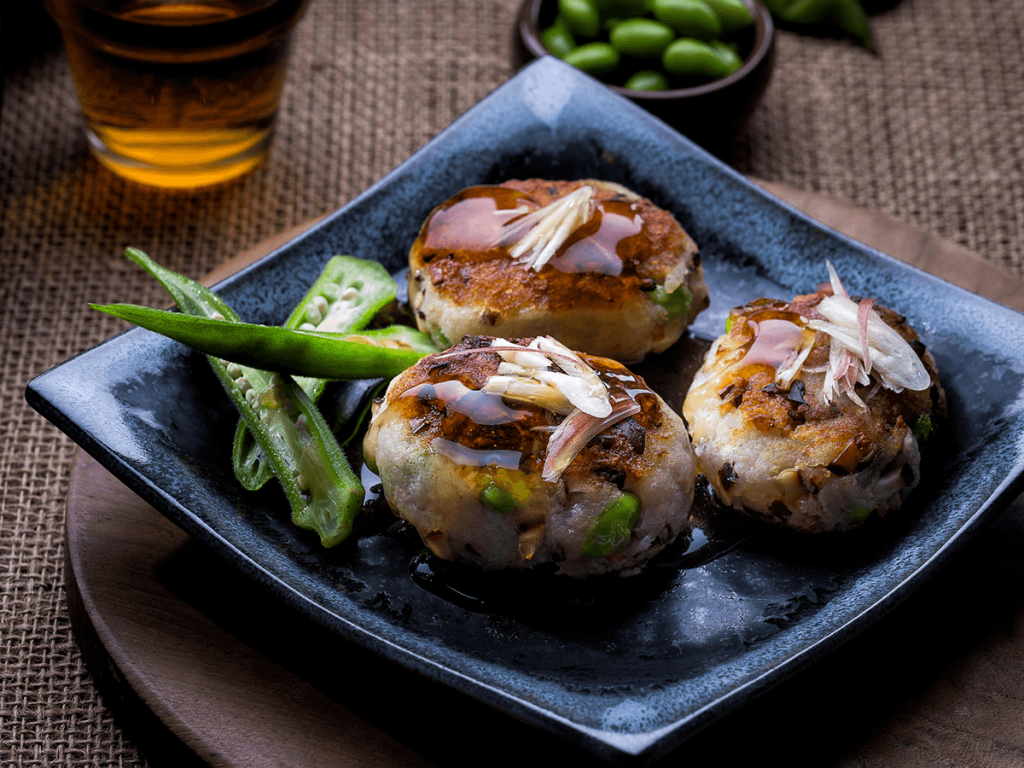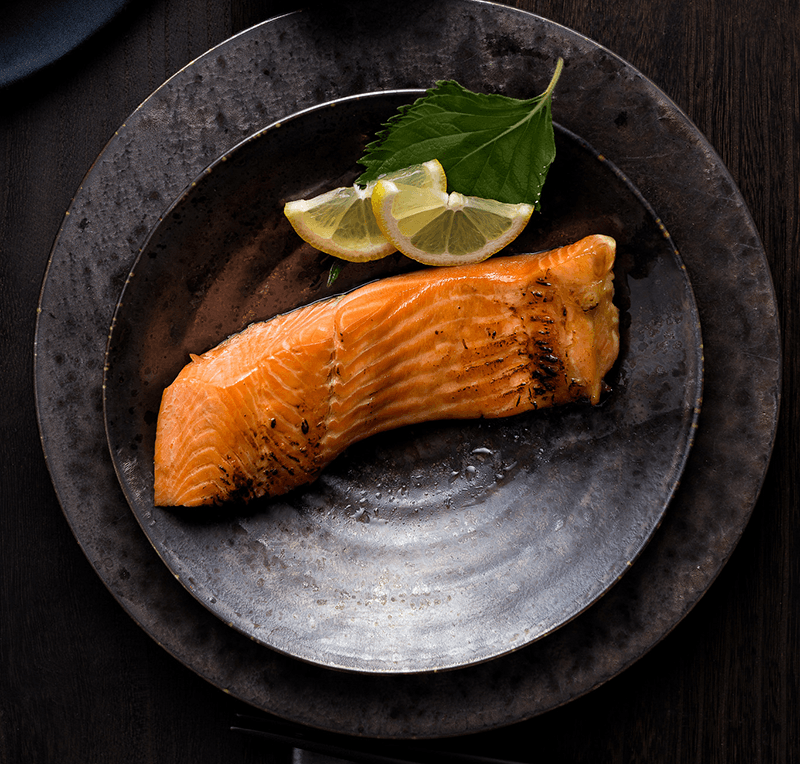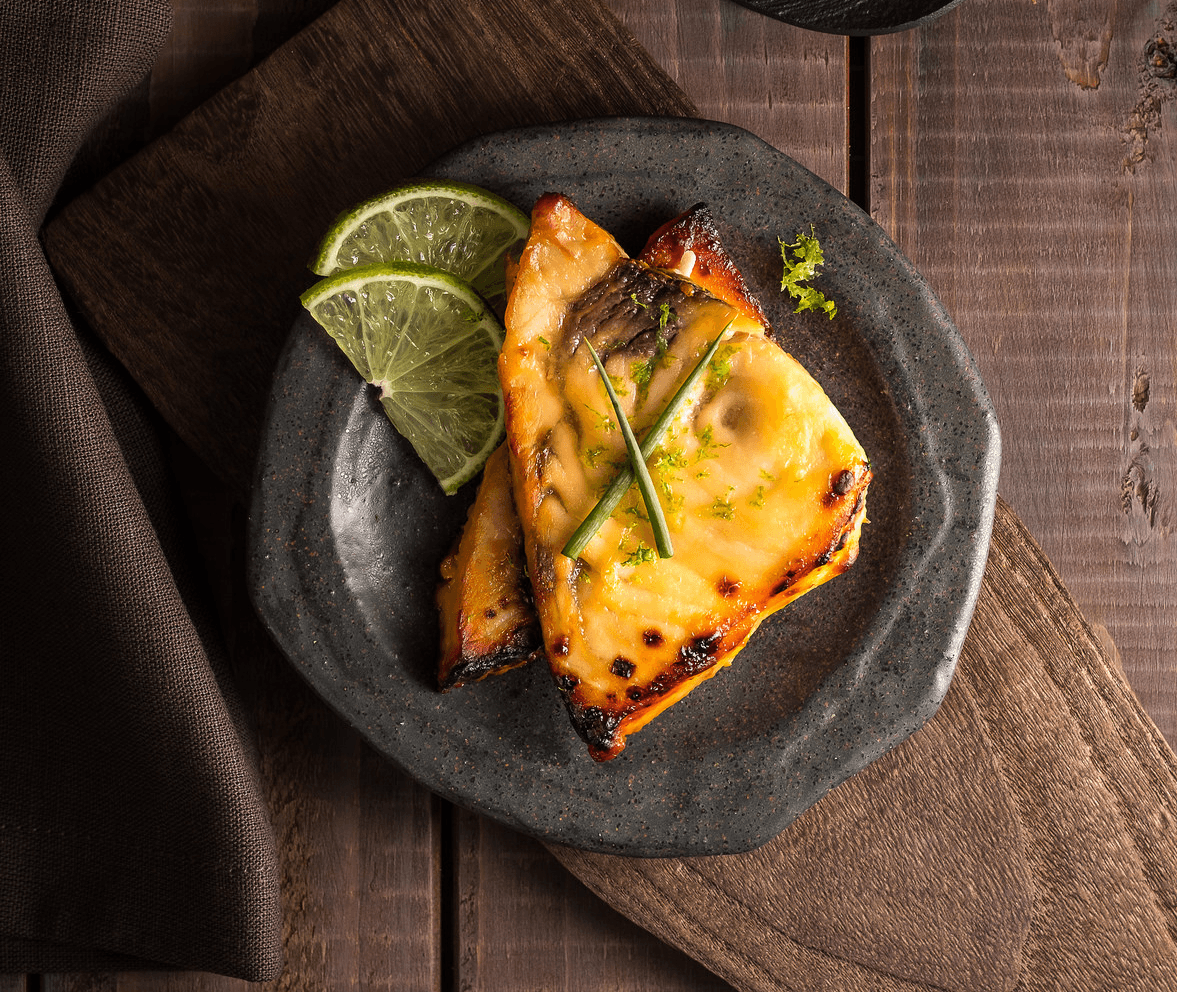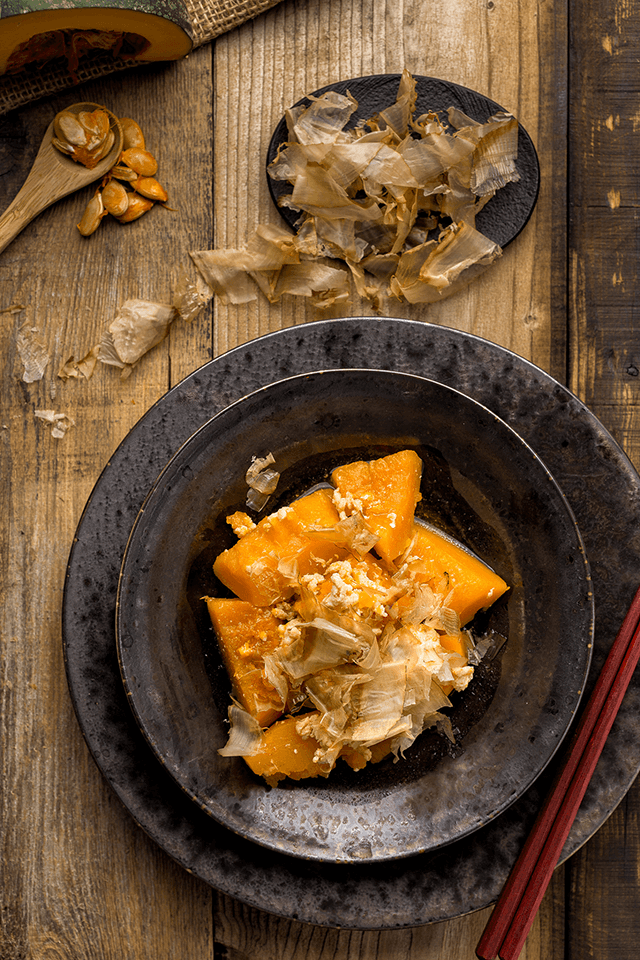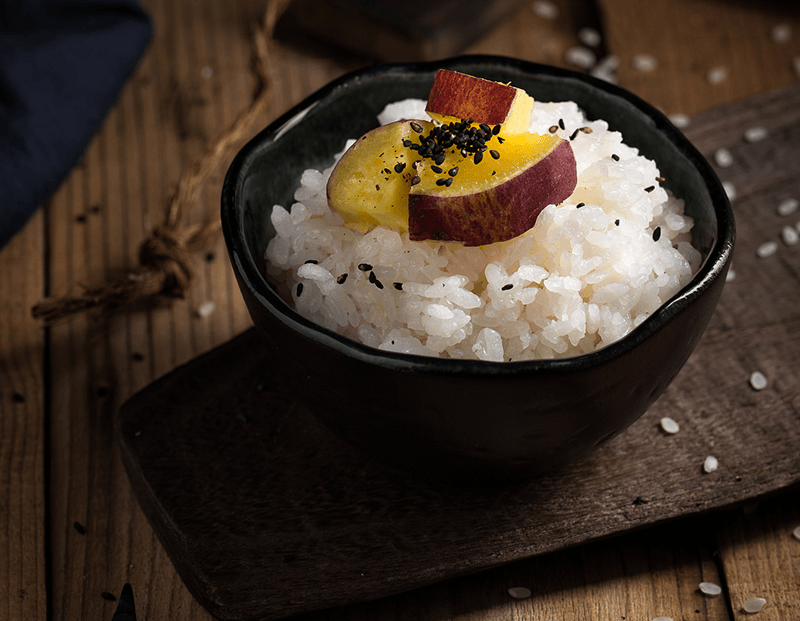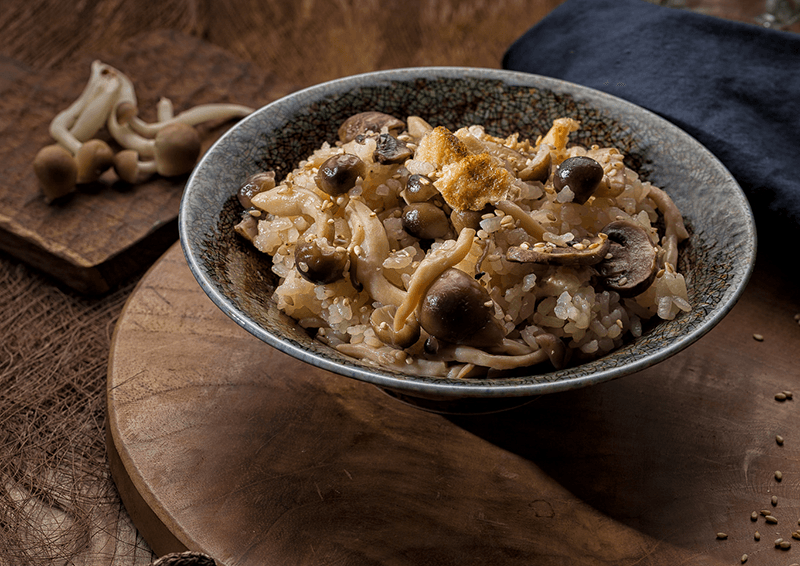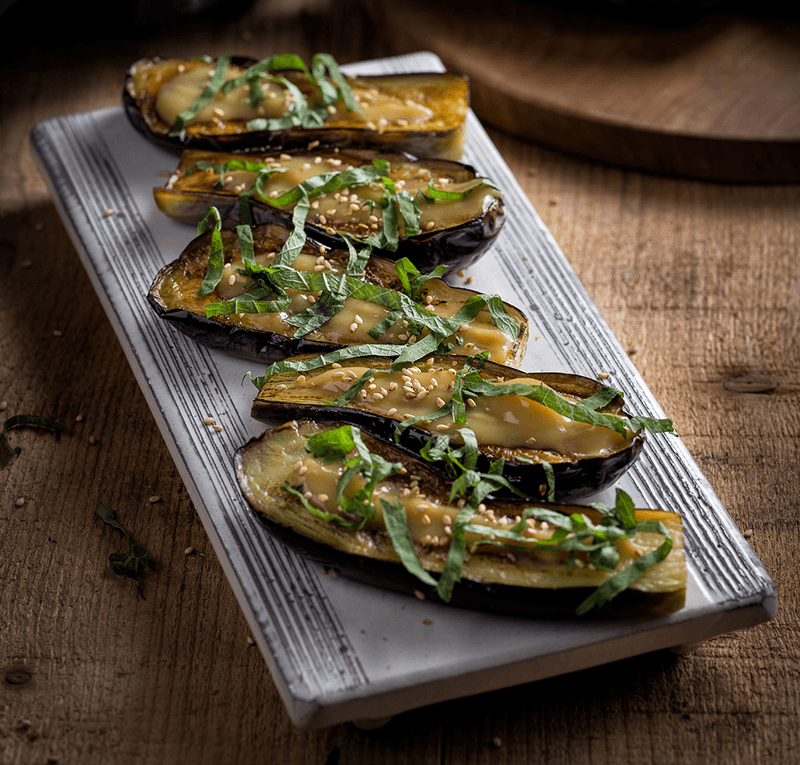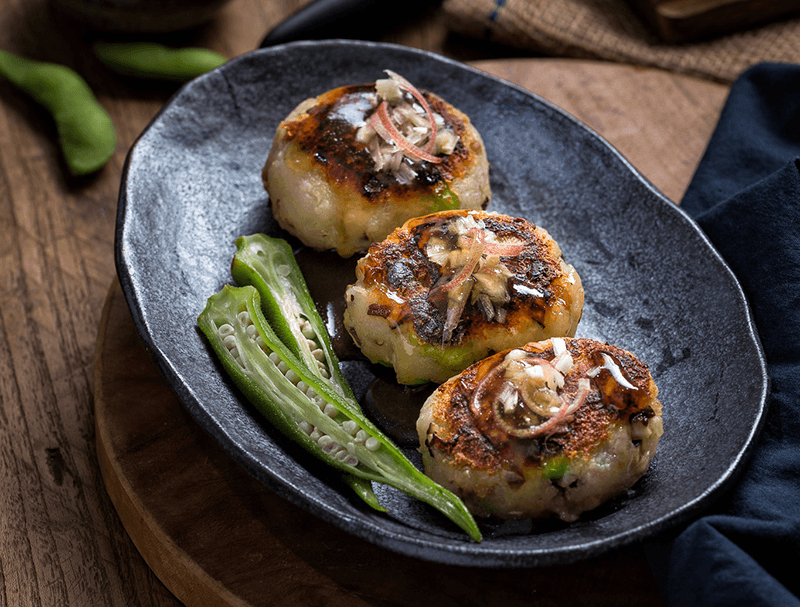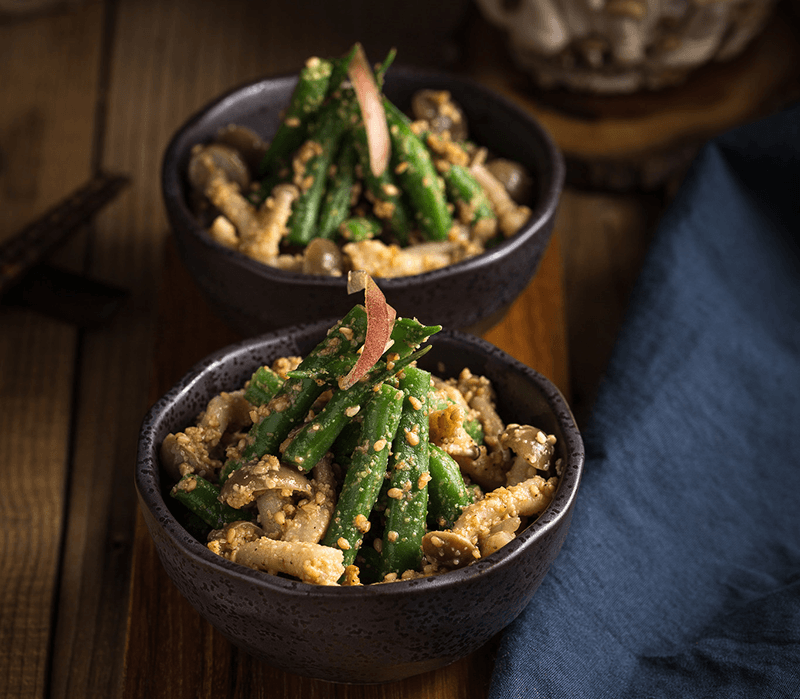As well as a lovely time for fall foliage, autumn in Japan is known as a great time for eating. Whether it has its origins in Japan’s agricultural roots, or just simply describes people getting their appetites back after a long, humid summer, the Japanese phrase shokuyoku no aki (autumn appetite) definitely rings true. These are nine recipes that highlight some of the best flavors that fall has to offer, from mushroom tempura to grilled salmon.
Yūan-Style Grilled Salmon
Yūan sauce is a simple and delicious marinade of sake, mirin and soy sauce (in equal proportions), often with yuzu or other citrus fruit. It owes its name to a famous tea-ceremony master of the Edo period who is said to have invented the dish. Fish is marinated for half an hour, then fried or grilled. The recipe works well with other fat fish (such as yellowtail or mackerel) as well as with chicken.
Ingredients (for 4):
Yūan sauce:
75 ml sake
75 ml mirin
75 ml soy sauce
½-1 yuzu (or alternatively lemon, lime, orange)
4 salmon fillets
Vegetable oil for frying
Method:
1. Combine sake, mirin and soy sauce in a pot and bring to a boil over medium heat. Continue simmering until reduced by 1/3. Turn off the heat and add peeled yuzu, cut in 1-cm slices. Let the marinade cool at room temperature.
2. Once the seasoning cools down completely, marinate salmon fillets in the mixture for 30 minutes.
3. Wipe the fish completely. Heat a small amount of vegetable oil in a pan over medium heat. Lower the heat and add the salmon. Fry for about 5 minutes with a lid on until golden brown. Coat each fillet with a spoonful of marinade and turn to the other side. Fry for another 5 minutes, coat the other side with the marinade and wait until the whole fish becomes golden brown.
Hints:
-Fresh yuzu can be replaced by a concentrate or other citrus juice (e.g. lemon, lime or orange).
-The sauce may be stored in the fridge for a couple of days.
Recipe courtesy of Fukuko Kisshy from Musubi Cooking Class in Tokyo.
Miso-marinated (Miso-zuke) Fish
This super easy marinade gives a fabulous taste to grilled fish. Just mix white (sweet) miso paste with mirin, spread over the fish and wait patiently for at least one day. This marinade is most often used with fish such as yellowtail, salmon or Spanish mackerel. But it also works well with chicken and even beef.
Ingredients (for 4):
4 pieces buri/yellowtail or other fish
8 tbsp white (sweet) miso
2 tbsp mirin
Method:
1. Sprinkle salt over fish fillets to remove fishy smell. Leave for around 40-50 minutes.
2. Wipe off the moisture from the fish with kitchen paper.
3. Mix miso and mirin. Paste over fish fillets.
4. Leave in the fridge overnight.
5. Preheat the oven to 180º C on fan-grill setting.
6. Remove most of the paste from the fish fillets. Place them on a greased sheet of aluminum foil and bake for some 15-20 minutes or until the fish is cooked through.
7. Decorate with yuzu (or other citrus) rind for more aroma.
A hint:
Be sure to wipe off most of the marinade before grilling, as it burns easily. If the fish is getting too dark before it’s done, you can cover it loosely with aluminum foil.
Recipe courtesy of Emi Hirayama from Uzuki Cooking Class in Kyoto.
Simmered Pumpkin
Contrary to the West, in Japan pumpkin is a very popular vegetable used almost throughout the year. A small, sweet and firm kabocha (pumpkin), often unpeeled, is transformed into aromatic soups, pickles or tempura. Kabocha simmered in a flavorful salty-sweet sauce will make a delicious and very easy autumn stew.
Ingredients (for 4):
1 small or half medium juicy kabocha
200 g finely minced meat (pork, chicken or turkey)
200ml water
2 tbsp soy sauce
2 tbsp sake
2 tbsp sugar
2 tbsp mirin
1 tsp instant dashi
1 tsp freshly ground ginger
Bonito flakes for garnish
Method:
1. Take away the pumpkin seeds and cut the pumpkin into bite-size pieces. You can also cut off their sharp edges to prevent the pieces from breaking into pieces as they bump into each other when cooking.
2. Put all the ingredients into a pot and bring to a boil.
3. Remove the scum once it appears with a thin sieve or a spoon.
4. Cover the pan with aluminum foil and keep it boiling at low heat until the pumpkin is cooked (you can easily insert a chopstick into it).
5. Serve immediately garnished with some bonito flakes.
Hints:
-Kabocha’s skin (while edible) is very tough. You can heat up the pumpkin in a microwave for 1-2 minutes to make cutting it easier.
-For a vegetarian version, you can simply skip the meat or replace it with other vegetables such as eggplant or zucchini.
Recipe courtesy of Kohei Yagi, Japanese food consultant and author of a Polish-speaking blog on Japanese cooking.
Satsuma-imo gohan
Takikomi-gohan (literally, “rice cooked with something else” – usually seasonal ingredients) is a popular dish in Japan and a great method for livening up plain rice. Sweet potatoes are a perfect complement to rice. Japanese sweet potatoes, known as satsuma-imo (potatoes of Satsuma Province) have purple skin and light flesh (that turns golden brown when cooked) and taste sweeter than other varieties. However, the recipe will work just as well with other types of sweet potatoes or yams.
Ingredients (for 4):
360 ml Japanese short-grain rice
400 ml water
1 sweet potato (around 200-250 g)
1 tsp salt
1 tbsp sake
Roasted black sesame for decoration
Method:
1. Put rice in a large bowl, pour in cold water and stir gently. Change the water and repeat until the water becomes almost clear.
2. Scrub the skin of the sweet potato but do not peel. Cut it into 1cm cubes and soak in water until ready to use.
3. Mix rice, water, salt and sake in a heavy pot. Top with sweet potato cubes and leave to soak for at least 30 minutes.
4. Bring to boil over high heat, with a lid on. Reduce the heat to low and cook for 10 minutes. Turn off the heat and steam with lid on for another 10 minutes.
5. Mix lightly with a wet spatula. Serve in small bowls, sprinkled with black sesame.
A hint:
If you are using a rice cooker, put the washed and soaked rice in the inner bowl, add water and other ingredients, and cook according to cooker’s instruction (there is no need to increase the amount of water because of the addition of sweet potatoes).
Recipe courtesy of Fukuko Kisshy from Musubi Cooking Class in Tokyo.
Kinoko no Takikomi gohan
Mushroom rice is another autumn classic. Kohei’s rice with mushrooms will serve both as an excellent accompaniment to a meal or as an independent dish. Delicate and fragrant, it’s a taste of autumn at its best.
Ingredients (for 4):
300-400g mushrooms (originally a mix of oyster and chestnut mushrooms but you can choose your preferred variety)
360ml/ 300g Japanese short-grained rice
1-1.5 pieces of aburaage
1.5 tbsp white sesame, toasted
For dashi:
400ml water
40g oyster mushrooms (ideally)
10cm piece of kombu or kombu powder
1 tbsp soy sauce
2 tbsp sake or dry white wine
1/3 tbsp salt
Method:
1. Prepare dashi. Put kombu in a saucepan with water, and leave it in a fridge for a minimum of 1 hour (ideally 1-2 days). If you’re in a hurry, you can also use kombu powder instead.
2. Cut or tear mushrooms for dashi into small pieces, add them to the water with kombu, and bring to a boil. Turn off the heat and let chill.
3. When chilled, add seasonings, mix well and strain.
4. Wash the rice. Pour the dashi into rice and let it soak for 50 minutes.
5. In the meantime, brown the aburaage on both sides on a frying pan without oil. Cut it into small pieces.
6. Cut mushrooms into small pieces and fry them without oil, stirring continuously, until soft.
7. Mix all the ingredients, including sesame, into the rice and bring to a boil over high heat, with a lid on. Lower the heat and keep on boiling for some 12 minutes or until all the water is absorbed by the rice. Turn off the heat and steam with the lid on for another 10 minutes.
8. Mix well and serve in small bowls.
Hints:
-If you use a rice cooker, put the washed and soaked rice in the inner bowl, add other ingredients and cook according to the cooker’s guidelines (there is no need to increase the amount of liquid because of the additional ingredients).
-In the off-season, you can use dried and soaked mushrooms, e.g. 4-5 heads of shiitake (for a more orthodox version) or porcini and boletes (for a western version). The liquid from soaking can be used to prepare dashi.
Recipe courtesy of Kohei Yagi, Japanese food consultant and author of a Polish-speaking blog on Japanese cooking.
Miso Glazed Eggplant
Miso glazed eggplant is a really easy and delicious appetizer or side dish. The meaty texture of eggplant and the sweet savory miso sauce make a perfect combination. The dish is particularly popular in Japan in the end of summer/beginning of autumn, when eggplants are at the peak of their season.
Ingredients (for 4):
For the egg miso glaze (tama miso):
100g white or yellow miso
2 tbsp sugar
2 tbsp mirin
2 tbsp sake
1 egg yolk
4 small Japanese eggplants (or 1 big western eggplant)
A pinch of sesame seeds for decoration
Method:
1. Combine all miso paste ingredients in a small saucepan. Stir over very low heat until achieving mayonnaise consistency.
2. If you’re using a large eggplant, cut it in 3 cm slices. Small eggplants can be cut in half lengthwise. Leave in water for 10 minutes and wipe well.
3. Add 2cm of vegetable oil to a pan and fry the aubergines over medium-high heat until golden brown and tender, approximately 7-8 minutes on both sides.
4. Arrange in small bowls. Top with 1 tablespoon of miso paste and sprinkle with sesame seeds.
Hints:
-Egg yolk is not necessary but it gives extra thickness to the sauce. If you’re using it, make sure to simmer the sauce over very low heat or it will scramble.
-Miso sauce keeps well in the fridge and can be used as a topping for other grilled foods too.
Recipe courtesy of Fukuko Kisshy from Musubi Cooking Class in Tokyo.
Lotus root (renkon) patties
Lotus root (renkon) is a typical autumn and winter ingredient in Japan. Quite inconspicuous from the outside, the small holes throughout its length make it very decorative when sliced. Crunchy when raw, it becomes smooth and sticky when grated. Steamed lotus root patties are a common dish in Kyoto but a fried version is Emi’s own creation. The sweet-soy topping sauce is also called amber sauce because of its beautiful color.
Ingredients (for 4 patties):
For the patties:
400 g lotus root
4 small dried shiitake mushrooms, soaked in cold water (ideally overnight)
4 prawns
1 tbsp sesame oil (for frying mushrooms and prawns)
4 tbsp boiled edamame beans
1 tbsp potato starch
1 tsp salt
Vegetable oil for frying
For the topping sauce:
240 ml dashi stock
2 tbsp soy sauce
1 tbsp light soy sauce
4 tbsp mirin
2 tbsp potato starch (or corn flour)
2 tbsp cold water
Method:
1. Peel and finely grate the lotus root.
2. Cut shiitake mushrooms into small cubes.
3. Peel the prawns, remove the veins and wash with cold water. Cut into small pieces and sprinkle with 1 teaspoon of sake.
4. Lightly fry shiitake and prawn pieces in sesame oil.
5. Transfer lotus root, edamame, shiitake and prawns into a bowl. Add potato starch and salt, and mix very well.
6. Form four patties and fry on medium heat until golden brown, approximately 4 minutes on each side.
7. Meanwhile, bring dashi stock, both soy sauces and mirin to a boil. Dissolve potato starch in cold water and add to the sauce. Stir constantly until thick and smooth.
Hints:
-Since it discolors very quickly, renkon should be kept in water with a drop of rice vinegar once peeled.
-Additional ingredients can be modified according to your taste. For instance, you can use other fresh mushrooms in place of dried shiitake and chopped scallions or boiled green beans instead of edamame beans.
-The topping sauce should be boiled well or it will become too watery afterwards. But be careful –
because it’s very sweet, it gets burnt easily.
Recipe courtesy of Emi Hirayama from Uzuki Cooking Class in Kyoto.
Sesame dressed salad
Boiled vegetables with sesame dressing is one of the most common side dishes in Japan. The rich, nutty dressing adds a fantastic depth to any vegetable. It goes particularly well with blanched green vegetables such as green beans, spinach, asparagus or broccoli. In autumn, it’s often served with mushrooms, such as boiled shimeji (as in the recipe below) or grilled shiitake. The dressing should be prepared just before use.
Ingredients (for 4):
6 tbsp sesame seeds
1 ½ tbsp soy sauce
1 ½ tbsp yuzu (or other citrus) juice
2 tsp raw brown sugar
1 ½ tbsp water or konbu stock
120g green beans
120g shimeji mushrooms
1 ½ tbsp sake
3 tbsp water
Method:
1. Cut green beans into 5cm pieces and boil in lightly salted water until barely tender (approximately 1,5 minutes).
2. Boil shimeji mushrooms with sake and water until barely tender (approximately 3 minutes).
3. Roast sesame seeds in a dry frying pan over medium heat until golden brown. Keep shaking the pan, as the seeds burn easily. If you are using roasted seeds, roast them quickly once again to enhance flavor and aroma.
4. Grind sesame seeds with a pestle in a ribbed mortar, leaving some 20% of the seeds coarse.
5. Add sugar, water, yuzu juice and soy sauce and mix well.
6. Add beans and mushrooms and mix again lightly.
7. Serve in small bowls, arranged in a pyramid.
Recipe courtesy of Emi Hirayama from Uzuki Cooking Class in Kyoto.
Mushroom tempura
Tempura (batter-fried food) is one of the most famous Japanese dishes but it was picked up in the late 16th century from Portuguese merchants who resided in southern Japan. This recipe uses maitake (hen of the woods) and shiitake mushrooms but it works perfectly with other types of mushrooms, vegetables such as green beans, sweet potatoes, pumpkin, eggplants and onion as well as fish and seafood.
Ingredients (for 4):
For tempura batter:
200 ml flour, chilled in the fridge
140 ml very cold, ideally sparkling, water
A pinch of salt
200g maitake mushrooms
200g shiitake mushrooms
Vegetable oil for frying
For dipping sauce:
1 cup dashi stock
1/3 cup mirin
1/3 cup soy sauce
1 cup finely grated giant white radish (daikon)
A few tsp finely grated fresh ginger
Method:
1. Start by preparing the dipping sauce: mix dashi, mirin and soy sauce in a saucepan, and bring to boil. Put away to cool.
2. Pat dry the mushrooms. Separate maitake mushrooms into bite-sized pieces. Remove the stems from the shiitake mushrooms and cut a cross on the cap.
3. In a bowl, lightly mix flour, salt and sparkling water. The consistency should be a little thicker than that of pancake batter.
4. In a pot or large pan, heat around 3 cm of vegetable oil to 180°C. You can check the temperature by dropping a bit of batter into the oil (the batter should descend slightly and then rise to the surface) or by inserting wooden chopsticks into the bottom of the oil (the oil should gently bubble around the chopsticks).
5. Dip mushrooms in the batter. Wipe off excess batter with your fingers. The batter should form a very thin coating.
6. Add a few mushrooms at a time to the hot oil. Do not touch until the batter becomes solid and crisp. When the bubbles around the mushrooms become smaller, turn them to the other side and fry until golden brown.
7. Retrieve mushrooms from the oil and briefly drain on a rack or paper towel.
8. Serve immediately with salt and/or dipping sauce.
9. Pour cooled dipping sauce into individual pots and mix with radish and ginger.
Hints:
-For a light and crispy tempura, it is important that the oil is hot and the batter is cold and prepared just before use.
-Make sure not to overmix the batter (or else the gluten will develop and it will become soggy) and to wipe off excess flour before frying.
-If you use sparkling water, the batter will be even crispier.
Recipe courtesy by Fukuko Kisshy from Musubi Cooking Class in Tokyo
Words by Anna Jassem and Aleksander Szojer
Photos by Wiktor Staniecki
This article is based on a chapter from Anna Jassem and Aleksander Szojer’s book, In the Rhythm of the Seasons: Japanese Customs and Home Recipes.

Tokyo Walking Food Tour at Night
Private Tokyo Tsukiji Market Tour
Enjoy Japanese Dishes with Locals at an Izakaya in Tokyo!
Learn healthy cooking from a Japanese mother near Ginza

